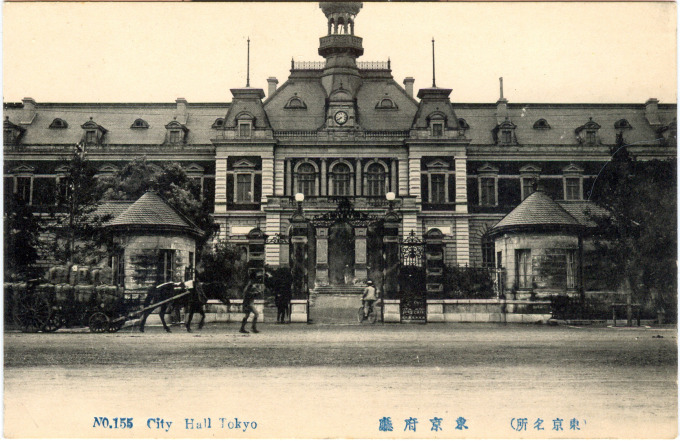
Exterior of the Tokyo Municipal Office (City Hall), c. 1930, with an inset photo of Mayor Horikiri Zenjiro (1929-1930). Prior to his appointment as mayor, Horikiri was the Director of the Reconstruction Bureau, which was in charge of urban planning and the rebuilding of Tokyo in the aftermath of the Great Kantō earthquake.
See also:
Tokyo Self-Government Commemoration, 1919
A Brief History of Tokyo
“In 1868, the feudal city of Edo, seat of the Tokugawa government, was renamed Tokyo, and the offices of Tokyo Prefecture (-fu) were opened. The extent of Tokyo Prefecture was initially limited to the former Edo city, but was rapidly augmented to be comparable with the present Tokyo Metropolis.
“In 1888, the central government created the legal framework for the current system of cities (shi) that granted some basic local autonomy rights – with some similarities to Prussia’s system of local self-government as Meiji government advisor Albert Mosse heavily influenced the organization of local government. But under a special imperial regulation, Tokyo City, like Kyoto City and Osaka City, initially did not maintain a separate mayor; instead, the (appointed) governor of Tokyo Prefecture served as mayor of Tokyo City. The Tokyo city council/assembly (Tōkyō-shikai) was first elected in May 1889. The city hall of Tokyo was located in the Yūrakuchō district, on a site now occupied by the Tokyo International Forum.
“In 1929, Horikiri Zenjiro was appointed Mayor of Tokyo City, after having overseen the reconstruction of the city as Director of the Reconstruction Bureau following the 1923 Great Kanto earthquake. At the end of 1930 he was appointed Vice Minister of the Ministry of Colonial Affairs. In 1932, Horikiri served as Director-General of the Cabinet Legislation Bureau in the administration of Prime Minister Saitō Makoto, and in 1933 was appointed Chief Cabinet Secretary. The same year, he was appointed to a seat in the Upper House (Peers Assembly) of the Imperial Diet of Japan.
“Following the surrender of Japan in 1945, Horikiri was appointed Home Minister under the Shidehara administration. During his tenure, he sponsored election reform laws to lower the minimum voting age to twenty, and reforms on women’s suffrage and eligibility for seats on in the Diet.”
– Wikipedia



Pingback: Tokyo City self-government commemoration, 1919. | Old Tokyo
Pingback: The creation of “Greater Tokyo,” 1932. | Old Tokyo